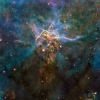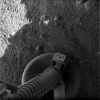NASA's Space Probes
Explorer Program
1958 - 2011
The Explorer program is a space exploration program that enables investigations from space. It started in 1958 and is still active today. Over 90 space missions have been launched to various destinations. A series of mostly small and medium sized satellites have been launched and form the backbone of the space science program exploring sciences such as astronomy, atmospherics and heliophysics. The most recent launch was in 2009 with the launch of WISE for infrared astronomy.
Pioneer Program
1958 - 1960
The Pioneer program was a series of unmanned space missions that was designed for planetary exploration. The Pioneer space probes have been the trailblazers of the space age, truly going where no man has gone before exploring the secrets of the Sun, Jupiter, Saturn, and the void beyond Pluto.
Ranger Program
1961
The Ranger program (1961 -1965) was a series of unmanned missions to the moon, which used vehicles called "crasher spacecraft". These spacecraft were designed to crash into the lunar surface and transmit data until the final impact. The mission was too much for the technology of the period and suffered a high failure rate and was labeled "shoot and hope". The last three missions of the spacecraft were simplified and all returned useful images of the lunar surface.
Mariner Program
1962 - 1973
The Mariner Program (1962-1973) mission's was the USA's first attempt at interplanetary travel... The Marine spacecraft visited Mercury, Venus, and Mars, and laid the groundwork for the US missions to the outer planets. There were ten (10) Mariner vehicles in the series, seven were successful and three were lost. In 1962 Mariner 2 became the first probe to fly past the planet (Venus). In 1964 Mariner 4 flew by Mars and returned the first close-up images of the Red Planet, followed by Mariner 9 which later took detailed photographs of Mars from orbit in 1971. Mariner 10 launched in 1973 became the first spacecraft to visit Mercury.
Lunar Orbiter Program
1966 - 1967
Between the years of 1966 through 1967 five (5) Lunar Orbiter Missions were launched. The missions would be mapping the lunar surface before the Apollo landings. The first three (3) were focused on taking pictures of those landing sites. Each of the following missions was to map the Moon to ninety-nine percent (99%) completion. All this was done to a resolution of twenty meters (20) by two meters (2) or 12 feet x 6.5 feet.
Surveyor Program
1966 - 1967
The Surveyor probes marked another first for the USA safely landing a probe on the Moon. The first mission (Surveyor I) lifted off on May 30, 1966 and the last (Surveyor 7) landing on the surface of the moon January 7, 1968. The mission of the Surveyor probes were to: obtain close-up images of the lunar surface and help determine if the terrain was safe for manned landings. Each Surveyor was equipped with a television camera able to send singles back to the earth. Surveyors 3 and 7 carried tools to collect soil samples of the surface.
Pioneer 10 and Pioneer 11
1972 - 1974
Pioneer 10 and Pioneer 11 were robotic space probes. Pioneer 10 was launched in 1972 and its mission was to send back data and images of Jupiter. It was the first spacecraft to reach escape velocity from our Solar System. Escape velocity is not generated from the constant use of a rocket but just providing an initial boost. You can think of this similar to kicking a football once you apply the initial force it's on its way under its own power. Pioneer 11 was launched in 1973 and mission was to study the asteroid belt around Jupiter and Saturn. Communications with both probes has long since been lost due to power constraints on the spacecraft.
Helios Probes
1974 - 1976
The Helios I and Helios II space probes program was a joint venture between NASA and the Federal Republic of Germany. The probes were launched into heliocentric (orbit around the sun) for the purpose of studying solar processes. Helios 1 was launched on December 10, 1974 and Helios 2 was launched on January 15, 1976. The probes had a maximum speed record among spacecraft at 157,078 mi/h. The probes completed their primary missions by the early 1980s, with Helios 2 sending data up to 1985. The probes are still remaining in their elliptical orbit around the Sun but no longer send data.
Viking 1 and Viking 2
1975
The Viking Mars missions were done by the Viking 1 and Viking 2 spacecraft. The two probes were launched within weeks of each other, with Viking 1 launching on August 20, 1975 and Viking 2 launching September 9, 1975. The Viking spacecraft consisted of an orbiter and a lander, which remained connected, for nearly a year until it reached Mars orbit. As the orbiters circled the surface of Mars they began taking pictures of the Martian surface. Analysis of these images by engineers on Earth enabled them to select a landing site.
Voyager 1 and Voyager 2
1977
The Voyager probes, launched in 1977 are carrying a greeting to any form of life. Taking advantage of a favorable planetary alignment the probes were launched to explore beyond our solar system. By the year 2020 both probes will be out of our solar system 10.5 to 12.5 billion miles away. Each carries, a 12-inch gold-plated copper disk containing sounds and images that portray the diversity of life and culture on Earth. As of December 2011 on Voyager 1 and Voyager 2 are still sending signals back and are on course to exit the solar system.
Pioneer Venus Multiprobe and Pioneer Venus Orbiter
1978
The Pioneer Venus Project involved the use of various spacecraft. The Venus Pioneer Venus 1 was launched in 1978 and was inserted into Venus Orbit to study the planet. The main objective was to investigate the solar wind in the Venusian environment, map the planet's surface through a radar imaging and study the upper atmosphere and ionosphere. The Orbiter remained in orbit as the Multirole spacecraft would be sent to probe the surface. The Multirole spacecraft carried one large and three small atmospheric probes. It was predicted that it would not survive the descent through the Venusian atmosphere. One of the Pioneer probes continued to function for forty-five (45) minutes after reaching the surface. It carried seventeen (17) experiments and operated until it ran out of fuel and was destroyed by the Venusian atmosphere in August 1992.
Galileo Probe
1989
The Space Shuttle Atlantis carried the Galileo space probe into its mission in 1989. Galileo would fly-by the Earth, Venus and the asteroid belt. Galileo approached its final destination in 1994 and returned images of the comet Shoemaker-Levy 9 crashing into Jupiter. When it reached Jupiter (in 1995) a parachute probe, separated from the orbiter and, gathered data on the planet's atmosphere as it descended to the surface. Galileo continued to orbit Jupiter and make close flybys of its main moons until it was intentionally destroyed in 2003. Galileo was able to discover that Jupiter's faint ring system consists of dust from impacts on the four small inner moons.
Hubble Space Telescope
1990
The Hubble Space Telescope was taken into space on the Space Shuttle Discovery in 1990. The Hubble Space Telescope has four main observation instruments that observe in the near ultraviolet, ultraviolet, visible, and near infrared, light. The images collected are assigned colors to make the colorful images the Hubble is famous for. The Hubble's orbit outside of the Earth's atmosphere allows it to take extremely sharp images with almost no background light. Its observations have led to breakthroughs in astrophysics, such as accurately determining the rate of expansion of the universe.
Mars Global Surveyor
1996
The Mars Global Surveyor launched in November 1996 and reached Mars on September 11, 1997. It was the USA's return to the planet after the Viking missions of the 1970's. With limited fuel onboard it was to run out of fuel April of 2003. In August of 2001 engineers found a way to steer the ship so it would use eight hundred percent (800%) less fuel extending its life. It completed its primary mission in January 2001 and finally failed to respond to commands on November 2, 2006. In January 2007 NASA officially ended the mission. The Surveyor spacecraft orbited the Mars planet twelve (12) times a day and used high-resolution cameras to explore the surface returning more than 240,000 images.
Mars Phoenix Lander
2007
The Phoenix lander was launched from the Kennedy Space Center in Florida on August 4, 2007 and landed on the surface of Mars on May 25, 2008. During its mission scientists used instruments to: 1. to explore the Martian arctic soils for possible indicators of life, past or present 2. to examine potential habitats for water ice, 3. to enhance our understanding of Martian atmospheric processes, 4. to measure volatiles, such as water and organic molecules in the northern polar region of Mars. The multi-agency program was headed by the Lunar and Planetary Laboratory at the University of Arizona, under the direction of NASA's Jet Propulsion Laboratory. The lander completed its mission in August 2008. In 2010 a flyby image of the Phoenix on Mars was taken. The image indicated that the probe had not survived the harsh Martian winter. One of the solar panels appears to be broken off. The mission was declared concluded on November 10, 2008, after engineers were unable to re-contact the craft.
Juno
2011
Juno was launched from Cape Canaveral Air Force Station on August 5, 2011. Juno is a NASA space probe called a New Frontiers mission. The mission will be to get information about the planet Jupiter. It will take five (5) years for Juno to reach Jupiter, reaching its destination July 4, 2016. At that time Juno will be placed in a polar orbit to study the planet's composition, gravitational and magnetic fields, and polar magnetosphere. Juno will also search for clues about: Jupiter's formation, weather, topography, core materials, presence of water atmosphere and mass. It is hypothesized that winds on the planet's surface can reach 370 mph, Juno will verify this hypothesis.
MAVEN
Projected for 2013
MAVEN - (The Mars Atmosphere and Volatile Evolution Mission), set to launch in 2013, will explore Mar's upper atmosphere, ionosphere and interactions with the sun and solar wind. Scientist hopes to gain information on the history of Mars atmosphere and climate. They want to collect data that will help determine the effect of various compounds specifically carbon dioxide, nitrogen dioxide, and water, on Martian history. The Maven mission is a joint venture between NASA and the University of Colorado at Boulder.
← Rovers
The light hitting the earth right now is 30 thousand years old.


































































































